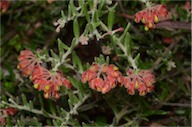In Flower This Week
A news sheet prepared by a Gardens' volunteer.
Numbers before each plant refer to temporary IFTW labels in the gardens.
Numbers in square brackets [ ] refer to garden bed Sections. Plants in flower are in bold type.
View past issues of 'In Flower This Week'.
27 May 2015
Grevillea saccata click for larger image |
Today we will walk from the Visitors Information Centre (VIC) along the Main Path.
- Notice on your right in a pot Astroloma foliosum [Section 174], commonly known as Candle Cranberry, a small shrub species which is endemic to the Perth region in Western Australia. This plant has very fine foliage and upright “firecracker” red tubular flowers with black and yellow tips.
- Further along on the left is Isopogon ‘Little Drumsticks’ [Section 210], a low bushy shrub with well-displayed yellow flower-heads.
- On your left at the start of the bridge is Olearia argophylla [Section 305], or Native Musk. It is a tall shrub or small tree with felted grey leaves and white strongly-scented flowers. It grows naturally in New South Wales, the Australian Capital Territory, Victoria and Tasmania.
- On your left is Banksia ‘Stumpy Gold’ [Section 131], with finely-toothed linear foliage and masses of short gold flower-heads with rusty red styles. This plant is a dwarf cultivar of Banksia spinulosa var. collina selected by Richard Anderson of Merricks Nursery in Victoria from material collected on the New South Wales Central Coast.
- On your left is Eucalyptus gregsoniana [Section 131], with a grey trunk and white fluffy flowers. The Wolgan Snow Gum or Mallee Snow Gum, as it is also known, is found in the highlands of New South Wales.
- On your right Acacia alata var. biglandulosa [Section 240], or Winged Wattle, has flattened phyllodes and masses of white fluffy balls of flowers. It is native to Western Australia.
- Go up the hill and bear right. Grevillea saccata [Section 30] in a pot on your left has weeping branches and pinkish-orange flowers. This shrub is endemic to the south-west region of Western Australia andcommonly known as Pouched Grevillea.
- On your left behind the pot is Grevillea diminuta [Section 30], with dark green foliage and rusty red bunches of flowers. It is native to New South Wales and the Australian Capital Territory. It was first formally described in 1962 from Mount Franklin, southwest of Canberra.
- On your right is a pink-flowered form of Correa alba [Section 30], a small upright bush with grey-green foliage. The species, which more commonly has white flowers, occurs naturally in sandy or rocky areas in coastal areas of south-eastern Australia.
- On your left is Banksia spinulosa var. neoanglica [Section 25], or New England Banksia, with silver-backed dark green foliage with yellow/gold upright flower heads. It is a shrub that grows along the east coast of Queensland and New South Wales.
- Banksia spinulosa var. spinulosa [Section 27], on your right, is found in open forests and woodlands of the coasts and mountains of New South Wales and Queensland.
- On your left is Banksia ericifolia ‘Red Clusters’ [Section 25], a small tree with green heath-like foliage and very large orange-red cones.
- Banksia spinulosa var. collina [Section 27], on your right a little further down the gravel path, has fine linear foliage and slender, dull gold cones. This shrub, commonly known as Hill Banksia or Golden Candlesticks, grows along the east coast of Queensland and New South Wales.
- On your right is Buckinghamia celsissima [Section 27], or Ivory Curl, a small tree with fragrant dense terminal clusters of ivory flowers. These trees grow naturally only in the Wet Tropics rainforest areas of north-eastern Queensland.
- Cross the road to see on your left Hakea cycloptera [Section 24], or Elm-seed Hakea, a small bush with thin spiky grey foliage and many curled pink blooms at the base of the leaves. It is native to South Australia.
Rosalind Walcott
![Director of National Parks [logo]](../../../../images/dnp_90px.gif)







